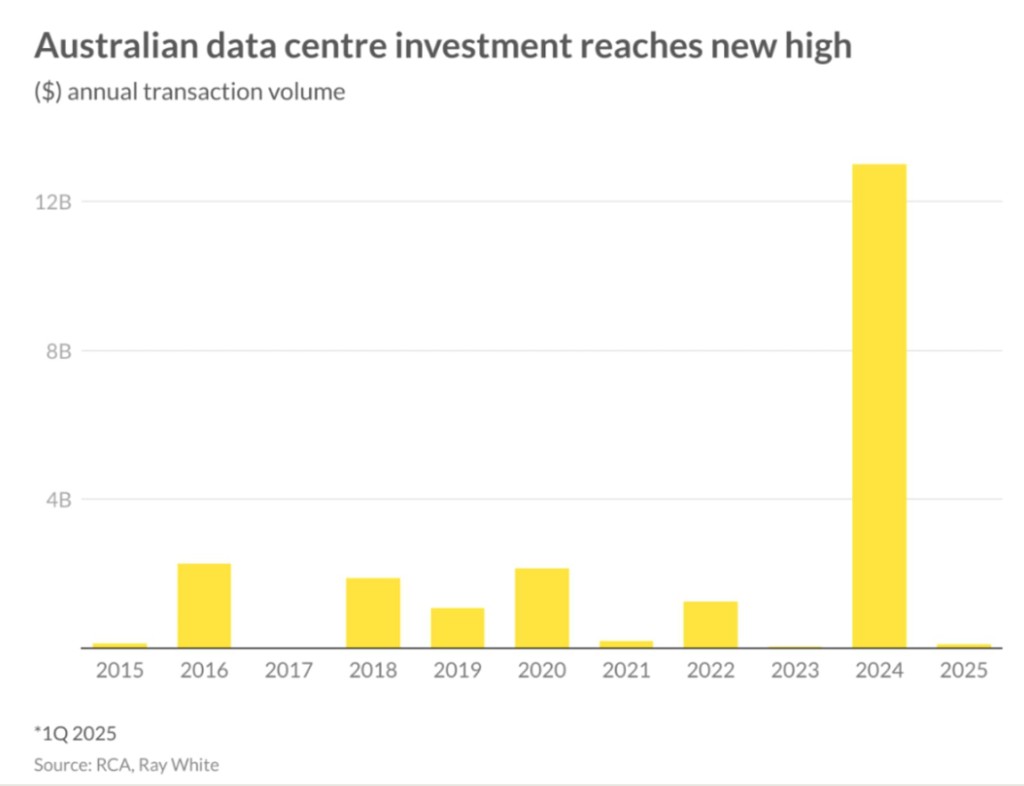
Australia is witnessing an unprecedented surge in data centre interest. An uptick in transaction activity and a strong new development pipeline will see investment projected to continue to outperform traditional commercial asset classes. This remarkable growth is reshaping the country’s digital infrastructure landscape and positioning Australia as a leading hub for data storage and processing in the Asia-Pacific region.
Total transaction volumes in the data centre sector have grown exponentially over the past decade, with sales in 2024 setting new benchmark highs in annual turnover. In 2024, we have recorded over $13 billion in investment activity (representing an incredible increase of 25,978 per cent on 2023 results) at yields of approximately 5 per cent. So far in 2025 only one sale has been recorded.

The buyer profile has evolved significantly, with international institutional investors (notably from USA and Canada), private equity firms, and specialist REITs now dominating the investment landscape. These sophisticated capital sources are deploying funds at unprecedented rates, recognising the strategic importance of Australian digital infrastructure. Forward-thinking investors are expected to be increasingly engaged in “land banking” strategies, securing prime sites years before development begins to ensure future expansion capability. Portfolio sales have become common as operators consolidate assets to achieve scale, with global hyperscalers emerging as the primary drivers of capacity expansion through both direct ownership and long-term leases of 10+ years.
Australia’s data centre capacity is set to more than double from 1,350 megawatts in 2024 to 3,100 megawatts by 2030. Sydney continues to dominate as Australia’s premier data centre market, currently accounting for more than half of the national capacity. However, Melbourne is rapidly gaining ground, with its data centre market expected to grow the fastest over the next five years due to favourable land availability and pricing. Significant investment is also now flowing into Perth, Brisbane, and Canberra, creating a more distributed national network of digital infrastructure, currently there are 30 data centre projects at various planning stages across Australia, which could see close to 2 million sqm of specialised space developed by 2030. Development models will continue to diversify, with investors taking phased approaches ranging from basic “dark shell” construction (essentially warehouse-type structures) to fully equipped “powered shells” with mechanical, electrical, and cooling infrastructure in place.
Several key factors are fuelling this expansion, including the rapid adoption of artificial intelligence technologies and cloud services creating unprecedented demand for computing power and storage. Major cloud providers including Microsoft, Google and Oracle are significantly expanding their Australian footprint. Australia’s strict data sovereignty regulations require certain data to be stored within national borders, necessitating local infrastructure investment. The accelerating digitisation of business operations, government services, and consumer activities is generating exponential growth in data creation and consumption. Australia’s strategic position as a gateway to Asia, combined with its extensive submarine cable network, makes it an attractive location for regional data processing.
Despite the sector’s robust growth, data centres face significant environmental, social, and governance (ESG) challenges. Data centres currently consume approximately 1 per cent of Australia’s total electricity, with this figure projected to reach as much as 8 per cent by 2030. The energy-intensive nature of these facilities raises concerns about their environmental impact in an increasingly carbon-conscious market. Cooling systems for data centres require substantial water resources, creating potential sustainability concerns particularly for the listed groups with aggressive ESG targets, actively pursuing investment into these assets. While data centre operators are increasingly committed to renewable energy sourcing, the transition from fossil fuels remains challenging. Australia’s shift away from coal-fired power plants by 2035 will necessitate alternative energy strategies for data centre operations.
As data centres become increasingly critical to national infrastructure, security concerns are paramount. The concentration of valuable data makes these facilities prime targets for cyber attacks, therefore protecting the physical infrastructure from unauthorised access or damage is a high priority. Ensuring continuous operation through redundant systems, backup power supplies, and disaster recovery capabilities is essential for maintaining data integrity. Despite concerns about technological obsolescence, the market benefits from remarkable tenant stickiness, this stability stems from the substantial operational risks and costs associated with relocating complex IT infrastructure, providing investors with relatively predictable long-term returns. The explosive growth in Australia’s data centre sector represents both a huge economic opportunity and a complex set of challenges. As investment continues to flow into this asset (infrastructure) type, balancing expansion with sustainability and security will be crucial for the industry’s long-term success and its role in Australia’s digital future.
_____________________________
Vanessa Rader | Head of Research

